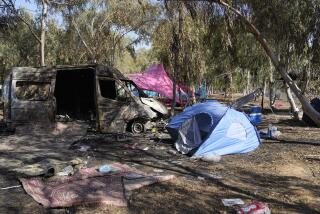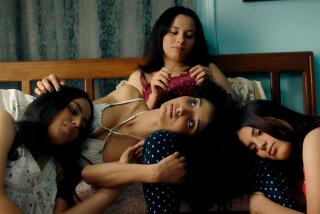Sectarian Violence Follows Egyptian Tale of Coptic Sex
- Share via
CAIRO — The worst sectarian violence in more than a year broke out here recently when a newspaper printed photographs allegedly showing a Coptic Christian monk having sex with parishioners at a site sacred to Copts, who believe it was once visited by Mary, Joseph and the baby Jesus.
The spark that propelled thousands of Copts to take to the streets in stone-throwing demonstrations was a report in the newspaper Al Nabaa. It said a monk had lured women to have sex in a monastery in the southern town of Asyut and then blackmailed them with secretly recorded videotapes. The article was accompanied by 14 pictures purportedly taken from one of the videos.
But the spontaneous and sustained public outburst, and the resolute response by the government to try to calm that anger, revealed the fragility of the peace that exists between Egypt’s Christian minority and its Muslim majority. Though Christians have long complained of institutional discrimination, and the government has consistently denied any such bias, Muslims and Christians generally keep their differences on an unofficial level. The government is eager to project an image of religious tolerance, and the Copts are careful to avoid antagonizing the government.
The sex scandal undermined that balance.
“No one should be surprised concerning the violent reaction of the Copts,” said Youssef Sidhom, chief editor of the Coptic newspaper Watani. “The Copts are used to taking it easy concerning maintenance of church buildings or denial of access to executive posts. But this is a completely different issue. They were attacked in their faith, their belief and their monastery.”
The case--with its mix of sex, religion and politics--has become the talk of Cairo, from upscale restaurants to storefront teahouses. Copies of the paper’s now-banned edition are passed around the way underground books were in the former Soviet Union. Newsstands have to turn away customers still looking for copies.
It began June 17, when the independent weekly hit the stands with this front-page headline: “Turning the Muharraq Monastery in Asyut into a whorehouse under the hand of the big bishop.”
Then, just above three photos that ran before the text, another headline said: “The right hand of the first man in Virgin Mary Monastery desecrates Christian women.”
The report charged that a monk, Adel Saadallah Gabriel, had seduced women in a 4th century monastery built on the site where Copts believe the infant Jesus was brought when Mary and Joseph fled to southern Egypt. The article charged that Gabriel lured the women, promising that he would cure their ailments, then secretly recorded the acts and demanded payment in cash or gold jewelry. Some victims allegedly paid as much as 400,000 Egyptian pounds, or about $104,000, to keep the tapes secret.
Pope Shenouda III, head of the Coptic Church, accused Al Nabaa of “exploiting a personal mistake to slander the monastery” and denied that Gabriel ever brought women into the monastery. Copts make up about 10% of Egypt’s 65 million people.
There was a widespread feeling among Copts that the report was intended to embarrass and discredit their community--especially since the monk had been defrocked seven years ago. This set off two days of demonstrations in Cairo and Asyut that left dozens of civilians and some police injured.
The government responded quickly, yanking remaining copies of the paper off newsstands and arresting Editor Mamdouh Mahran, who is charged with inciting sectarian sedition and publishing immoral photos.
Still, when the editor was released on the equivalent of $2,500 bail Wednesday, 3,000 angry protesters turned out in Cairo, hurling stones at police, who fought back with water cannons.
Brother Thomas Qussia from Asyut said the newspaper article was merely the final straw. He said anger started to boil over in February when courts acquitted all but four of 96 defendants charged in connection with Muslim-Christian clashes in January 2000 that killed 20 Christians--and one Muslim--in El Kusheh, again in the south. That was the worst sectarian violence to hit Egypt in many years.
“This particular incident hit the holiness and the pride of the Coptic community,” Qussia said Sunday. “In Upper Egypt, some of the Muslim community took the pictures and started to joke about the Christian faith.”
Qussia said many in the church do not believe the pictures are of Gabriel, but that even if they are, they have to have been taken long after he was defrocked. Qussia said the man in the video is quite fat, whereas Gabriel was lithe when he lived at the monastery from 1984 to 1996.
The editor is scheduled to go to trial Sunday and faces up to 12 years in prison. The former monk is being held in jail while the authorities try to determine if the allegations are true. For now, the Coptic community is satisfied with the government’s response--including a move by officials to reprosecute some of those acquitted in the 2000 deaths. But there is a wait-and-see attitude.
“If this case had been left or denied or treated with negligence, like previous cases, it could have led to riots in the streets, and maybe it would have led to dangerous actions,” Sidhom said.
More to Read
Sign up for Essential California
The most important California stories and recommendations in your inbox every morning.
You may occasionally receive promotional content from the Los Angeles Times.













